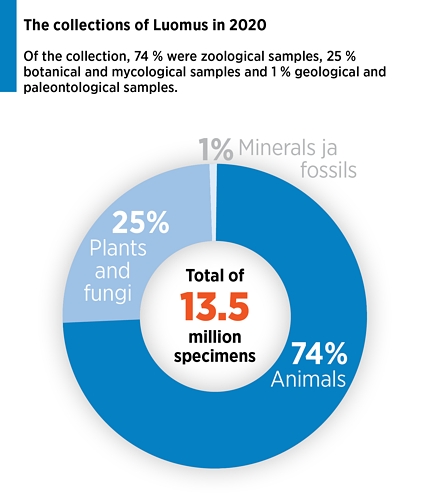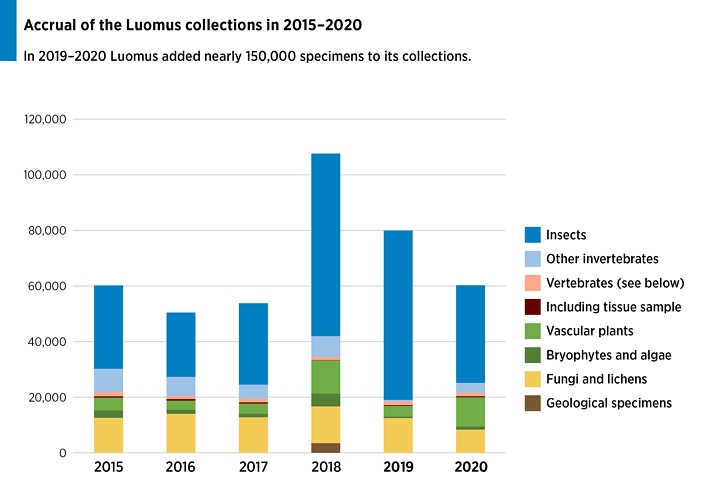COLLECTION ACCRUAL
The collections of Luomus feature more than 13,5 million specimens (Table 5) and approximately 8 000 living plant accessions.

COLLECTION ACCRUAL
Tens of thousands of specimens are added to the collections every year in accordance with the general collections policy of Luomus. In 2019 the zoological collections exceeded a total of 10 000 000 specimens. Luomus accumulates its collections through specimen exchange as well as collection donations (see below) from institutions and individuals. Luomus also organises international and national expeditions to build up its collections.
HOW MUCH GROWTH?
In 2019–2020 Luomus added nearly 150 000 specimens to its collections: 103 000 zoological specimens and 36 000 botanical and mycological specimens (Table 6). No new geological specimens were added in the collections in 2019–2020.

COLLECTION DONATIONS
Donations are a significant source for the accumulation of Luomus collections. Over the years, the institutions of University of Helsinki have ceased their collection activities, the specimens from which have then been incorporated into the Luomus collections permanently. The Botanic Unit, for example, has received over 200 000 specimens over the years in the form of many large donations: such as those from the herbariums from the Research Institution of Plant Pathology in Finland in 1974, the Research Institution of Forest Management in 2000 and the Department of General Botany in 2009. The collections from the Department of Horticultural Science have also been donated to Luomus’ Botanical Museum. In addition, Luomus has received large donations from other research institutions.
Only specimens that have a scientific value are accepted into the collections. The final size of the donations becomes clear after all samples have been registered, which in some larger cases might take several years.
The Zoology Unit received several donations in 2019 and 2020. One of the most valuable donations was the Veikko Huhta collection consisting of 462 specimens and 170 species of mites from the order Mesostigmata. The donation was received in 2017, but it was added to the collection in 2020. In addition, Luomus received a significant donation of flatworm type specimens: 61 specimens and 29 species in total. They were collected in the Democratic Republic of the Congo (donors Maarten Vanhovelt and Auguste Chocha Manda, Hasselt University), the Ivory Coast (donor Enoutchy F. Bouah, Université Félix Houphouët-Boigny) and Cuba (donors Yander Diaz and Tom Artois, Hasselt University).
A set of 61 specimens and 9 species were chosen from an extensive earthworm collection collected from field habitats in Finland. The earthworms were donated by the Natural Resources Institute Finland (Luke). The biggest donation was received by the registered association Jääkausi Istiden, which included a skeleton of an African Bush Elephant.
The donated Pekka Sundelin collection included butterflies collected in Finland, some of which are rare or were new species for Luomus collections. As part of the collection, Luomus also received a butterfly collection from Thailand in 2019 including undescribed species, type specimens and new species for Luomus collections. In 2020 Luomus received a donation from G. G. E. Scudder containing specimens of the suborder Heteroptera. The specimens were collected in Australia, Asia, Africa and North America and some of them were type specimens. The Gunnar Stenius beetle collection included a wide range of species and specimens both from Finland and abroad.
In 2019–2020 the Botany Unit received donations including 14 326 vascular plant specimens. There were 183 different donors in total, some of them private persons. Among the most extensive donations were the donation of 2156 specimens from the Department of General Botany (University of Helsinki), 632 specimens from the Research Institution of Forest Management (University of Helsinki) and 576 specimens from the Finnish-Russian School.
LIVING SPECIMENS – PLANT ACCESSIONS
In the collections of living plants and seeds at the botanic gardens, the collection unit is the plant accession. The collections may feature several accessions of the same species, and correspondingly, an accession may cover a single individual plant or several plants from the same seed batch. Even though the collections grow every year with new plant accessions, older accessions may be removed if the plants die or the plantings are changed. This means that the annual collection accrual may also be negative.
In January 2019, the botanic gardens housed a total of 7968 perennial plant accessions and 5163 taxa, in January 2020 the numbers were 8104 and 5274. These numbers are approximate because the plant accessions are being updated at the moment.